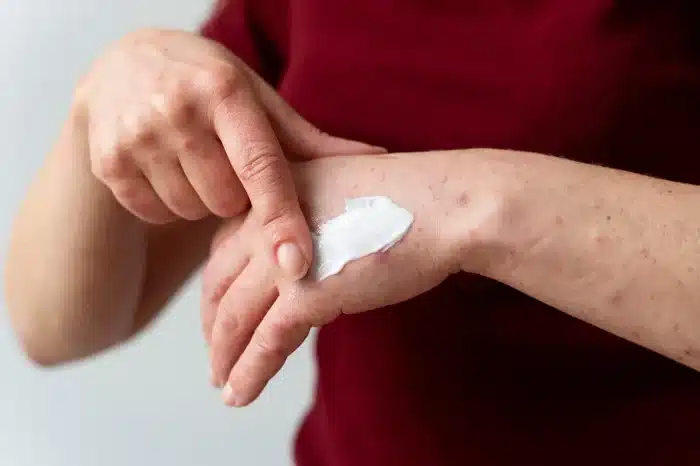
Burn injuries are among the most painful medical conditions, requiring effective pain management strategies to improve patient outcomes. A systematic review published in the Journal of Plastic, Reconstructive & Aesthetic Surgery highlights the potential of topical anesthetics like EMLA cream to provide procedural pain relief for small burns, while cautioning against its use on large burn areas due to risks of systemic toxicity.
EMLA cream, a eutectic mixture of lidocaine and prilocaine, is widely used for local anesthesia in intact skin and chronic wounds. While its efficacy in reducing pain is well-documented, its application on burned skin raises questions about safety and effectiveness, especially for larger or deeper burns.
In this article, we will explore whether EMLA cream can be safely applied to burns, examining its benefits, risks, and clinical recommendations for usage.
Key Takeaways
- EMLA cream is not recommended for use on open or deep burns, as damaged skin increases drug absorption and the risk of systemic side effects.
- Mild, superficial burns (like first-degree sunburns) may tolerate limited use under medical supervision, but this is not standard practice.
- Serious side effects, such as methemoglobinemia, are rare but possible—especially in infants, the elderly, or when applied to large areas.
- Safer pain relief alternatives for burns include cold compresses, oral painkillers, aloe vera, and hydrogel dressings.
- Always consult a healthcare provider before applying EMLA or any anesthetic cream to burns, especially for children or larger injuries.
About: Doctor Medica is your trusted supplier of top-quality dermal fillers, viscosupplements, and more for your medical practice. We offer genuine products from leading brands at the lowest prices. Contact the Doctor Medica team today to order EMLA Cream online for your practice.
Safety Considerations for Application on Burn Injuries
Applying EMLA cream directly onto a burn is generally discouraged, especially for second- or third-degree burns. Burned skin is compromised, which alters drug absorption and significantly increases the risk of systemic toxicity. For superficial, non-blistered first-degree burns, some clinicians may permit limited use under close supervision.
However, it’s critical to assess the burn’s severity before considering any topical anesthetic, including EMLA.
Potential Benefits and Risks in Burn Management

In certain clinical settings, EMLA may reduce discomfort during debridement or dressing changes for partial-thickness burns. Its numbing action can make painful procedures more tolerable. However, practitioners must weigh these potential benefits against risks such as:
- Increased systemic absorption
- Possible delayed wound healing
- Local irritation or allergic reactions
These risks make EMLA a controversial option in burn care, and not a first-line treatment.
Increased Drug Absorption and Altered Pharmacokinetics
Burned or inflamed skin lacks the protective barrier that normally regulates absorption. This means lidocaine and prilocaine—the active agents in EMLA—can enter the bloodstream at higher levels.
Elevated concentrations may trigger serious EMLA cream side effects such as dizziness, seizures, or methemoglobinemia, especially in pediatric or elderly patients with thinner skin.
Alternative Pain Management Strategies for Burns

To manage burn pain safely, healthcare providers often recommend the following options:
- Cold Compresses: Reduce inflammation and provide quick relief
- Oral Analgesics: Drugs like ibuprofen or acetaminophen can help systemically
- Topical Burn Creams: Products like silver sulfadiazine or aloe vera support healing
- Hydrogel Dressings: Soothe pain while maintaining moisture balance
These alternatives offer safer pain control without the systemic risks associated with topical anesthetics on damaged skin.
Wound Care and Clinical Guidelines
Proper burn care depends on following clinical protocols. Basic recommendations include:
- Avoid applying any creams on broken or blistered skin unless advised by a doctor
- Clean the wound gently with saline or a mild antiseptic
- Cover with a sterile, non-stick dressing to prevent infection
- Seek medical attention for large burns or burns on sensitive areas like the face, hands, or groin
Conclusion
Can you put EMLA cream on a burn? For most burn types—especially open or deep burns—the answer is no. The compromised skin barrier increases the risk of systemic absorption, potentially leading to serious reactions.
While there may be controlled situations where EMLA offers relief, safer alternatives are usually preferred. Always consult a healthcare professional to determine the best treatment for burn care.
FAQs
1. Can EMLA cream be used on minor sunburns?
EMLA is not typically recommended for sunburns. While it may numb the area, the damaged skin increases the risk of absorption. Cooling gels or aloe vera are safer options.
2. What happens if EMLA cream is applied to a blistered burn?
Blistered or open burns may absorb EMLA rapidly, increasing the likelihood of systemic toxicity. This can lead to symptoms like dizziness, headache, or even methemoglobinemia.
3. Are there specific burn types that EMLA can treat?
EMLA may be used in controlled clinical settings for superficial partial-thickness burns during procedures like debridement. However, its use is limited and should be supervised by medical professionals.
4. What are safer alternatives for burn pain relief?
Safer alternatives include cold compresses, over-the-counter pain relievers, aloe vera gel, and topical burn creams like silver sulfadiazine. These options help relieve pain without compromising safety.
5. What are some precautions when using EMLA cream?
Always apply EMLA only to intact, non-inflamed skin, avoiding large areas or prolonged use. Follow dosing instructions carefully, and never use on broken or blistered skin unless directed by a healthcare provider.
6. Can EMLA cream delay wound healing?
Limited evidence suggests that improper or excessive use of EMLA may delay wound healing due to local irritation or allergic reactions. Use under medical supervision to minimize risks.
References
World Health Organization: WHO. Burns. Published October 13, 2023. https://www.who.int/news-room/fact-sheets/detail/burns
Rangatchew F, Schoelzer L, Drzewiecki KT, Holmgaard R. EMLA cream in burns: A systematic review of safety, analgesic efficacy and effects on burn pathophysiology. Journal of Plastic Reconstructive & Aesthetic Surgery. 2024;95:386-401. doi:10.1016/j.bjps.2024.04.001
Lillieborg S, Aanderud L. EMLA anaesthetic cream for debridement of burns: a study of plasma concentrations of lidocaine and prilocaine and a review of the literature. Published October 25, 2017. https://pmc.ncbi.nlm.nih.gov/articles/PMC5665840/
Related Articles
Joanna Carr
Intraline Filler Reviews – Patient and Practitioner Feedback on Effectiveness
Discover patient and practitioner feedback on the effectiveness of Intraline Fillers. Learn about the benefits, results, and real-world experiences wi...
Joanna Carr
Depo Provera Generic – What is Medroxyprogesterone?
Medroxyprogesterone is the generic form of Depo Provera, a contraceptive injection used to prevent pregnancy.
Joanna Carr
Is Lanluma FDA Approved – What’s the Status?
Wondering if Lanluma has FDA approval? Get the latest scoop on its legal status, safety, and whether you can find it in U.S. clinics anytime soon.


